Using Artificial Intelligence Techniques to Detect Extremism in Social Media Content
Main Article Content
Abstract
Environments, posing significant threats to both social and psychological security. This extremism appears in various forms, including violence, terrorism, and extremist crimes, with detrimental impacts on individuals, especially younger generations. Consequently, there is a pressing need to adopt evidence-based solutions involving preventive, educational, and social interventions to address this growing phenomenon.
As extremism escalates, the role of technology and artificial intelligence (AI) in combating it has become more crucial, positioning it as a key focus in behavioral health and social science research. In this context, the study presents a hybrid model for detecting harmful and extremist content by analyzing URLs on social media platforms, utilizing AI and machine learning techniques. The research evaluated several algorithms, including Logistic Regression, Support Vector Machines (SVM), Decision Trees, Random Forest, and K-Nearest Neighbors (KNN). The proposed hybrid model demonstrated outstanding performance, achieving an accuracy rate of 100% in detecting harmful content—outperforming individual models, particularly Logistic Regression, which achieved an accuracy of 81.7%. These findings highlight the hybrid model’s effectiveness in reducing classification errors and enhancing the detection of digital threats.
Article Details
Issue
Section

This work is licensed under a Creative Commons Attribution 4.0 International License.
